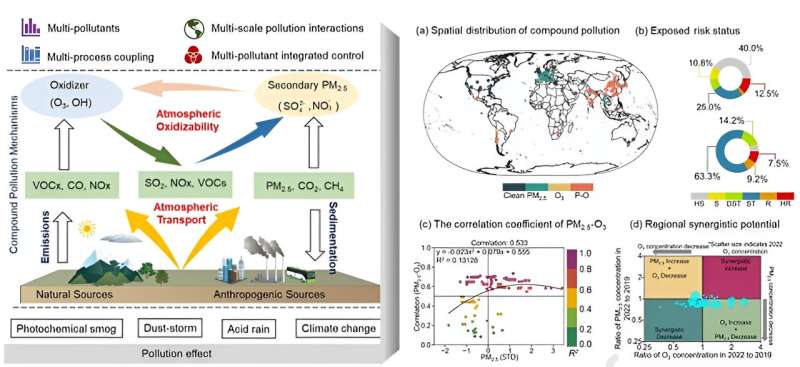This article has been reviewed according to Science X's editorial process and policies. Editors have highlighted the following attributes while ensuring the content's credibility:
fact-checked
trusted source
proofread
Tackling the dual threat: A global strategy for PM2.5 and O3 pollution

Air pollution is a severe risk to human health and the environment, particularly from fine particulate matter (PM2.5) and ozone (O3). Despite global efforts, many cities continue to face significant exposure risks from these pollutants.
PM2.5 and O3 originate from similar sources and interact in complex ways, compounding their harmful effects. Addressing these intertwined pollutants requires innovative strategies. Due to these challenges, it is necessary to conduct in-depth research to develop effective strategies for joint PM2.5 and O3 control.
A research team from Hubei University of Economics, Nanjing University, and Yangtze University conducted a study on the spatial and temporal patterns of PM2.5-O3 compound pollution. Published in Eco-Environment & Health, on 19 April 2024, the research analyzed data from 120 cities worldwide between 2019 and 2022, proposing a framework for synergistic pollution control. The research is published in the journal Eco-Environment & Health.
The study revealed that nearly 50% of cities worldwide are affected by PM2.5-O3 compound pollution, with hotspots in China, Korea, Japan, and India. Significant spatial correlations between PM2.5 and O3 concentrations were identified, driven by common precursors such as nitrogen oxides (NOx) and Volatile Organic Compounds (VOCs).
The analysis showed that 52.5% of the cities achieved coordinated reductions in PM2.5 and O3, with average decreases of 13.97% and 19.18%, respectively. This highlights the potential for joint pollution control measures. The proposed framework aims to manage emissions from both pollutants simultaneously, leveraging their spatial and chemical interactions.
Key findings included the identification of cities with high exposure risks and the demonstration of a positive spatial correlation between PM2.5 and O3 concentrations, suggesting that integrated control strategies could significantly enhance urban air quality and public health.
Dr. Chao He, lead author of the study, stated, "Our findings underscore the critical need for integrated pollution control strategies. By addressing PM2.5 and O3 together, we can more effectively reduce the health risks and environmental impacts associated with these pollutants."
The proposed synergistic control framework offers a promising approach to managing global air pollution. Implementing these strategies could lead to significant improvements in urban air quality, reducing health risks and promoting sustainable development. Policymakers and environmental agencies can use these insights to develop more effective regulations and interventions for cleaner, healthier cities.
More information: Chao He et al, Synergistic PM2.5 and O3 control to address the emerging global PM2.5-O3 compound pollution challenges, Eco-Environment & Health (2024). DOI: 10.1016/j.eehl.2024.04.004
Provided by Chinese Academy of Sciences





















